Can Post-Concussion Syndrome Cause Stuttering?
Many people associate stuttering with childhood, but a sudden onset of stuttering can also occur after a head injury. This phenomenon, known as acquired stuttering, is one of many symptoms that can...
Published peer-reviewed research shows that Cognitive FX treatment leads to meaningful symptom reduction in post-concussion symptoms for 77% of study participants. Cognitive FX is the only PCS clinic with third-party validated treatment outcomes.
READ FULL STUDY

Recovering from post-concussion syndrome (PCS) is challenging, but with the right guidance, substantial progress and symptom relief are possible, even years after the initial injury.
The concussion recovery process takes time, and patients often need to manage symptoms for months or years. These tips, curated by our doctors and therapists who specialize in treating post-concussion syndrome, can help you navigate that journey.
If you’re experiencing persistent symptoms such as headaches, brain fog, fatigue, memory problems, vision changes, and more, months or years after a concussion, you’re not alone—and you’re not crazy. These are real symptoms caused by changes in the brain and autonomic system, and they can be helped. Over 90% of our patients experience significant recovery after treatment in our clinic. To determine if our program is right for you, please schedule a consultation with our team.
Here’s the difficult reality when it comes to getting good medical care for post-concussion syndrome: most healthcare professionals and general practitioners aren’t equipped with the knowledge or resources to treat PCS (this includes most neurologists). In fact, many doctors still recommend what’s known as “cocooning”—sitting in a dark room, avoiding bright light and screens, and getting rest until you start to feel better. This is outdated advice and can actually harm and prolong the recovery process.
If your symptoms persist after a concussion, the most effective path forward is to find a clinic that specializes in treating PCS.
PCS recovery requires a multidisciplinary approach that stimulates neuroplasticity—the brain’s ability to form new neural pathways. Left untreated, the brain often forms inefficient or even harmful pathways leading to many difficult symptoms: fatigue, headaches, poor memory and concentration, mood changes, sleep disruption, light sensitivity, and more.
In addition, concussions can also affect other body systems, causing autonomic nervous system dysfunction, visual and vestibular dysfunction, and hormone dysfunction. A combination of physical, cognitive, vision, and vestibular therapies can redirect this process toward healing.
A comprehensive treatment plan must address all these factors. At Cognitive FX, we do exactly that. Using advanced brain imaging called functional neurocognitive imaging (fNCI), our team pinpoints the regions of your brain that have been affected by your injury and works together to treat your brain and its interconnected systems, focusing on the root causes of symptoms.
Treatment is an important starting point, but successful recovery also depends on follow-up care and the lifestyle changes outlined below.
You may find it helpful to read some of our patient recovery stories:
Quieren is a Cognitive FX patient from the Netherlands who suffered from PCS after a bike accident.
Sam Gray sought treatment 33 years after a brain bleed.
Myrthe van Boon is a mother of two who struggled with debilitating post-concussion symptoms for years before finding Cognitive FX.
Olivia Seitz is a former figure skater who found symptom relief after more than a decade of chronic illness.
Sam Pembleton was an adolescent hit by a soccer ball in the head; she tried treatment methods for five years before finding Cognitive FX.
These patients all completed video testimonials about their initial injury and their experience at Cognitive FX.
Further reading: Find a PCS clinic near you
If a specialized clinic isn’t accessible, you may still be able to find individual therapists who have experience treating symptoms of mild traumatic brain injury (mild TBI). While coordination between healthcare providers is more difficult, piecing together therapy through different clinics is a better treatment option than no treatment at all.
Therapies that may help include:
Physical therapy: Physical therapy can help patients regain some of the abilities lost due to head trauma and speed up overall recovery. For example, tailored exercises can help improve coordination and balance, address vision issues, relax neck and head muscles, and help patients overcome exercise intolerance.
Cognitive therapy: Also called cognitive rehabilitation therapy, cognitive therapy focuses on improving areas of cognition, such as memory, attention, problem-solving, organization, executive function skills, and word finding.
Speech and language therapy: Speech therapists—or speech-language pathologists (SLPs)—can treat various symptoms related to speech, communication, and language, many of which affect patients with brain injury. These include, for example, difficulties with speaking, understanding language, memory, stuttering, and word retrieval.
Vision therapy: The most common method of treating patients with vision symptoms is with neuro-optometric rehabilitation. This personalized therapy addresses specific visual deficits common after a brain injury, including problems with accommodation, focusing, eye teaming, and tracking.
Vestibular therapy: Vestibular therapy is a specialized form of physical therapy used to treat dizziness, balance problems, and other symptoms that can arise after a concussion. It focuses on improving the connection between the inner ear, the eyes, and the brain to help patients improve their posture and reduce symptoms.
Note: The huge advantage of attending treatment at a clinic like Cognitive FX is that all of these therapies are administered and coordinated under one roof. Our therapists from different disciplines share the progress and challenges of each patient, allowing each therapy to be informed by the others and enabling us to achieve better and faster results for our concussion patients.
In addition to physical and cognitive symptoms, PCS patients may experience significant changes to their mental health. Brain injuries can worsen pre-existing mental illness or cause new symptoms, such as anxiety, depression, mood swings, anger, post-traumatic stress disorder (PTSD), and more.
You shouldn’t just ignore your emotional challenges in the hope that they will disappear. You need to receive treatment for the brain injury itself as well as for any mental health difficulties that arise, such as depression and anxiety.
In our view, the best option is cognitive behavioral therapy (CBT). CBT is based on the idea that cognitive, behavioral, and emotional patterns are all connected, and changing one in a good way can influence all the others. Studies show that CBT can be used to treat anxiety, depression, insomnia, post-traumatic stress disorder, and several other mental health conditions in PCS patients.
Further reading:
Many of our patients come to us with multiple prescribed medications to treat common symptoms, including painkillers for headaches, sleeping tablets, antidepressant medications, and others.
However, these medications are rarely effective. To date, there is no medicine clinically proven to treat post-concussion syndrome. The reality is that medications commonly used for PCS patients were not developed or tested for these patients. As a result, the underlying issues remain untreated and symptoms persist, even if patients experience temporary improvements. Furthermore, some patients end up on so many medications that the side effects are just as bad—or worse—than the original concussion symptoms.
Further reading: Medication for concussion and PCS
Many patients with both whiplash and concussion turn to chiropractors or osteopaths for relief. These providers offer non-invasive, drug-free treatments, often using spinal manipulation techniques to realign misaligned neck joints after injury. While these adjustments can help some patients, it’s critical to choose a practitioner with specific experience treating whiplash, especially in the context of head injury.
Neck manipulations must be performed with great care to avoid further harm. Unfortunately, there are many reports of inadequate or even damaging treatments, underscoring the importance of selecting a qualified, experienced provider.
Even with an experienced chiropractor, you’ll likely need multiple sessions, and the relief they offer may only last a few days. That’s because spinal adjustments don’t address the underlying causes of your symptoms.
In contrast, Cognitive FX uses a comprehensive approach that combines aerobic exercise, multidisciplinary therapies, and mobility and strengthening exercises to treat the root issues behind both whiplash and concussion symptoms (more on this below).
Further reading:
Regular aerobic exercise promotes blood flow to the brain and triggers the release of vital neurochemicals that stimulate brain function. For example, brain-derived neurotrophic factor (BDNF) improves communication between cells, enhances cognitive function, and improves mood. This post-exercise cognitive boost continues for hours after exercise and is crucial in healing from brain trauma.
Some patients experience exercise intolerance with symptoms aggravating every time they exercise. We still advise exercising regularly, but for short periods to ensure they stay below the threshold at which their post-concussion symptoms appear. This is called exercising at sub-symptom threshold.
In practical terms, we advise patients to follow the Rule of Three to determine when they need to stop.
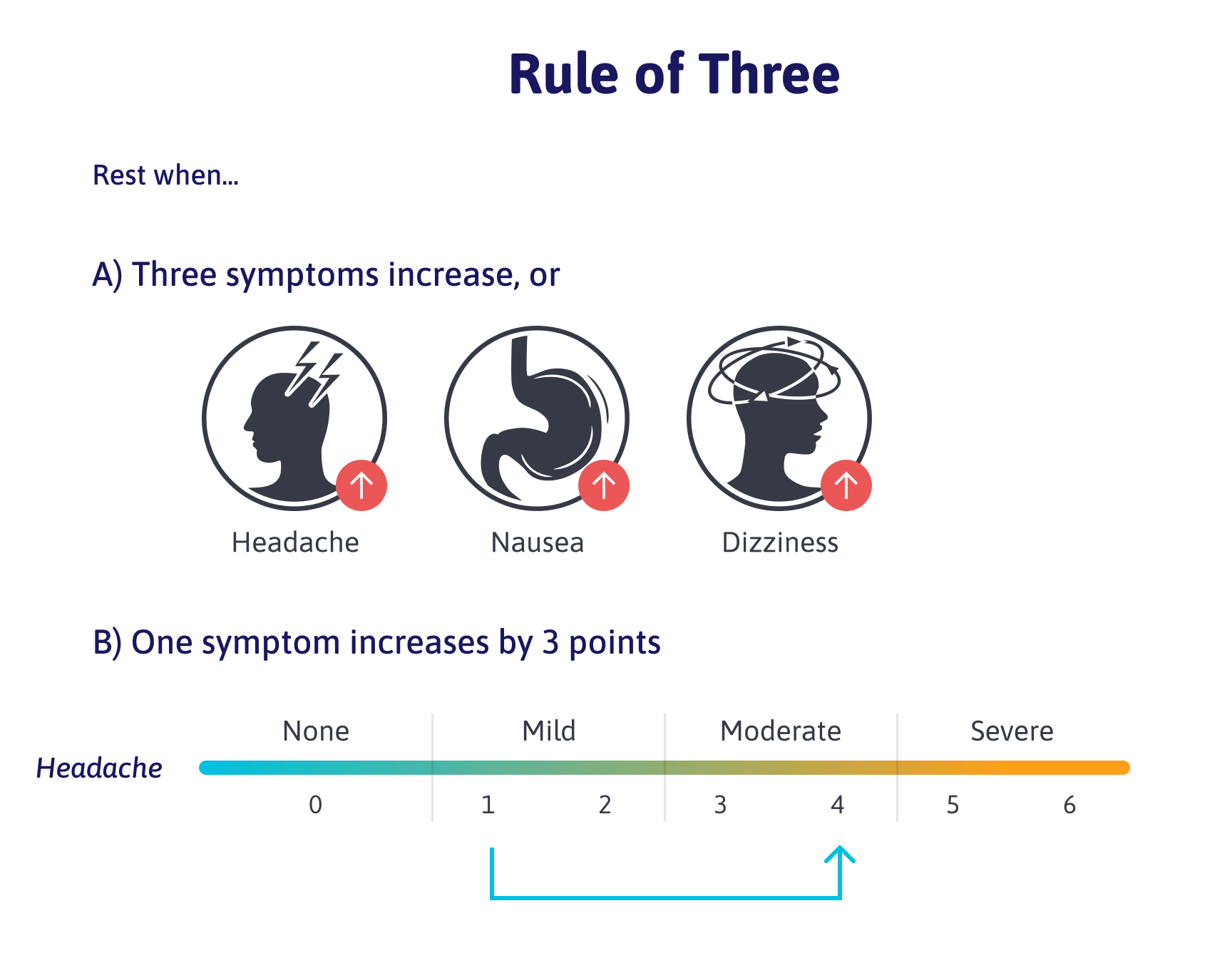
If you notice a worsening of three symptoms, such as a headache, nausea, and dizziness, then it’s time to stop.
If the severity of one symptom, such as a headache, increases by three on a six-point scale (according to your self-evaluation), then it’s time to stop.
Further reading: Exercise after a concussion
Cognitive exercises that involve decision-making and problem-solving skills help the brain re-establish neural pathways affected by the concussion. These activities improve cognitive functions like memory, attention, and processing speed, and help patients recover faster.
We advise engaging in cognitive games immediately after exercise to take advantage of the cascade of neurochemicals that stimulate brain function.
Suggested activities include:
Reading a book: If you’re struggling with concentration, start with short periods of reading and gradually increase the duration and complexity.
Playing cognitive games: Engage in different games that require different cognitive skills. In another article, we suggest 17 cognitive games that you can play alone or with a friend. These games can help with various PCS symptoms, including memory problems and difficulty concentrating.
Being creative: Consider art projects, crafting, or other creative pursuits.
Socializing with friends: Enjoy going out with friends and family members. Even just engaging in simple conversation with loved ones can stimulate different cognitive functions, including language processing, planning, and attention.
Further reading: Cognitive exercises to do at home
A healthy diet can help your brain heal faster after a head injury. Our recommendations include:
Protein: Meat, fish, eggs, and beans are the best sources of protein. Nuts and seeds provide some protein as well. Protein sources provide the brain with essential amino acids used as building blocks for neurotransmitters and other important molecules.
Healthy fats: Fats and oils are critical for a healthy nervous system and cognitive function. Healthy sources include fish (rich in omega-3 fatty acids), avocados, olive oil, and nuts. For example, docosahexaenoic acid (DHA) is an omega-3 fatty acid known for its role in maintaining healthy brain cells. It also has anti-inflammatory properties, which can help after a concussion, as patients experience increased inflammation in their brains.
Carbs: Get your carbs mainly from fresh fruit and whole grains. Fruit is a great source of energy for your brain throughout the day. Many fruits are also good sources of fiber, which may reduce brain inflammation and help with digestion. In small amounts, complex carbohydrates from whole grains can also be helpful because they supply the brain with a steady supply of sugar over time, instead of a large hit all at once.
Micronutrients: Antioxidants fight inflammation, and vitamins and minerals are essential micronutrients for biochemical processes throughout your body. Spices and fresh herbs, fruit, and vegetables are good sources of antioxidants, vitamins, and minerals.
Sodium: The exact amount of sodium needed varies from patient to patient. Some people need to reduce dietary sodium to keep their blood pressure down, while others may have low or dysregulated blood pressure and could benefit from a slightly higher sodium diet. Don’t adjust your sodium based on something you read online; consult your doctor on what’s best for your health.
Further reading: Nutrition for PCS patients
Living with persistent PCS symptoms can be stressful, which in turn may delay your recovery and affect your daily activities. Patients should learn to identify and manage their stress triggers and incorporate relaxation techniques into their daily routine.
Some suggestions include:
Patients dealing with lingering PCS symptoms need frequent rest periods during the day when symptoms flare up, or even better, before they are forced to stop an activity due to fatigue.
To be considered a therapeutic break—one which benefits your injured brain—you must change the part of the brain that you’re using. For example, concentrating on work relies on an area of the brain responsible for logical thinking and executive function. To have a break, you need to do something that doesn’t rely on this area, such as closing your eyes and allowing yourself to daydream or listen to music.
A good break does not necessarily mean doing nothing. Some examples of good breaks throughout your day:
At Cognitive FX, we recognize that short periods of cognitive and physical rest are an essential part of therapy—so much so that they’re an integral part of our rehabilitation approach (more on this below).
Further reading: Taking breaks is good for you
It’s not uncommon for PCS patients to experience trouble sleeping. Some patients sleep more than normal but still feel drowsy during the day (hypersomnia), while others have difficulty falling asleep or staying asleep (insomnia).
Our advice is to avoid relying on sleeping pills (see our considerations about medication above), but to adopt a healthy bedtime routine:
Go to bed and get up at the same time every day, even on holidays and weekends. Consistency is your friend.
Engage in a relaxing activity before bed, such as listening to calming music or reading a book. Avoid screen time before going to bed.
Avoid caffeinated drinks after lunch. Opt for non-caffeinated tea and coffee as an option if you want a hot drink.
Use chamomile, lavender, or lemon balm in ointment form or on your pillowcase.
Use a sleep app to regulate your breathing when you’re ready to fall asleep.
Keep your room clean, clutter-free, and at a comfortable temperature.
Consider taking melatonin supplements.
Further reading: PCS and sleep
Our last practical tip involves joining a support group specifically for PCS or TBI patients. It can be a source of great relief to find peer support from people who have gone through what you have, can listen without judgment to your story, validate your experiences, and offer recommendations based on what helped them in their recovery journeys.
A good support group can offer:
A safe place for you to ask questions and tell your story.
Practical coping strategies from other PCS patients to improve your quality of life.
Recommendations regarding concussion treatment types and providers.
“Accountability buddies” for people who want to build healthier habits to take care of their brains.
Some groups are designed to exchange personal stories and get emotional support, without getting into medical details. Others may allow participants to share resources they found helpful, describe what treatments worked and didn’t, and recommend doctors. Make sure you know what the group’s rules are before joining, so you can pick the most appropriate one for you.
If you’re looking for an in-person group, the best place to start your search is with the Brain Injury Alliance. Each state has different resources; most of them should have information on what brain injury support groups exist and how to join them.
Further reading: How to find a good PCS support group
At Cognitive FX, we understand that the best way to speed up your recovery time is by knowing exactly how and where the concussion has affected your brain. Our rehabilitation program is designed to address the root cause of your symptoms, rather than treat individual symptoms in isolation.
Our treatment, Enhanced Performance in Cognition (EPIC), is an intense, individualized program designed to treat each patient’s specific physical, cognitive, and emotional symptoms.
Our treatment process begins with an in-depth evaluation, which includes:
A meeting with one of our doctors to review the patient’s medical history and symptoms of post-concussion syndrome.
A physical exam to check balance, hand-eye coordination, reaction times, and other physical abilities.
A psychological evaluation to identify symptoms of anxiety, depression, and other mental health problems.
A structural brain and cervical spine MRI to spot any serious structural injuries that need medical treatment before patients start with us.
A brain imaging scan called Functional Neurocognitive Imaging (fNCI) to determine where and how the patient’s brain was affected by the injury.
Instead of strictly conducting interviews with the patient about their symptoms, as you’d experience at most concussion clinics, we take a more accurate approach and scan the brain. Specifically, we use Functional Neurocognitive Imaging (fNCI) to map how different areas of the brain are functioning after a concussion or brain injury.
This advanced fMRI scan measures two key things:
Regional brain activity: How much oxygen each brain region uses during specific cognitive tasks (indicating underactive, normal, or overactive function).
Connectivity between regions: How well different parts of the brain communicate with each other.
The scan results are visualized through intuitive charts and brain maps. These help us identify whether a patient is experiencing hypoactivity (under-functioning), hyperactivity (over-functioning), or a mix of both—and where.
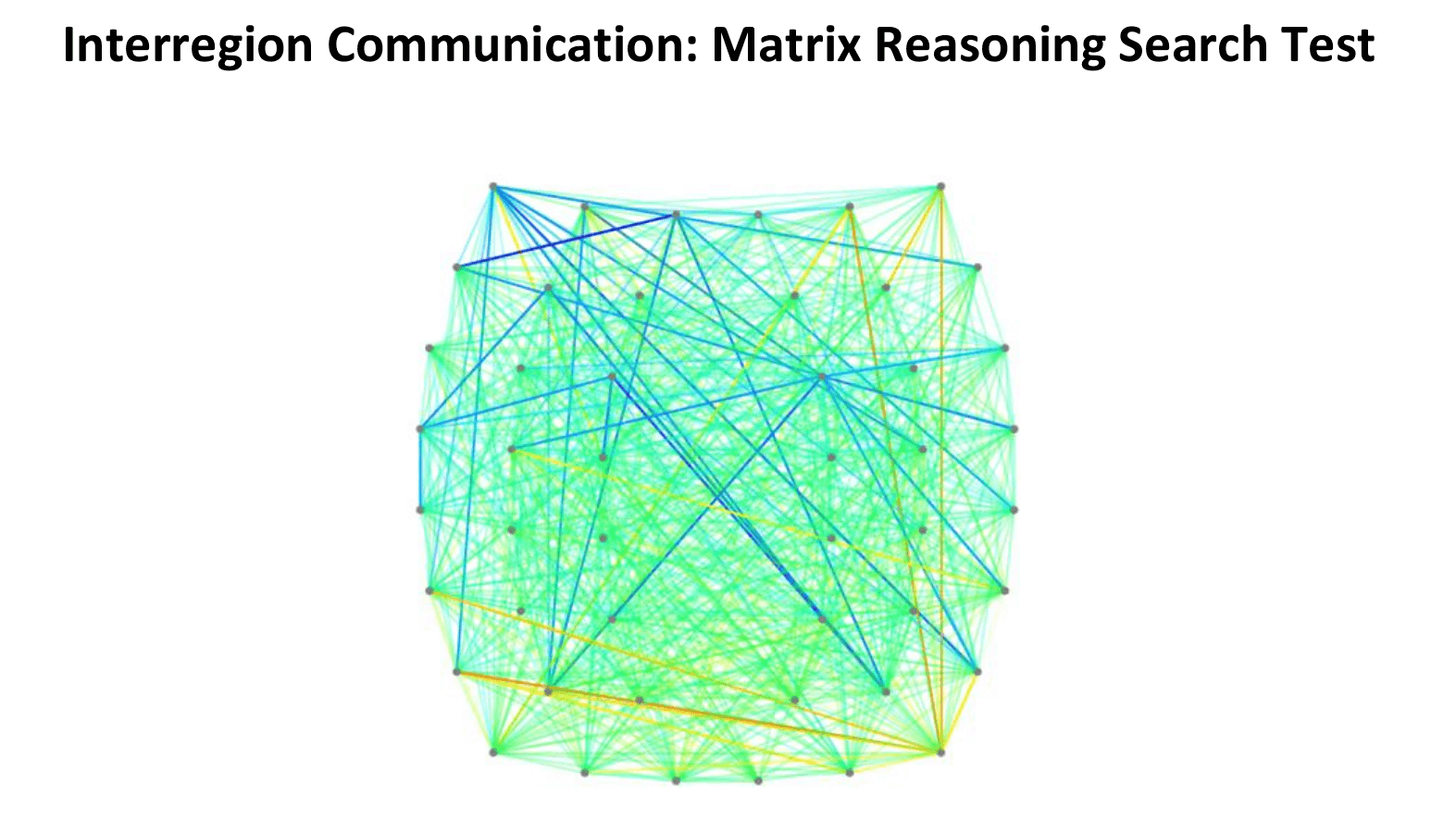
In this connectivity map, cooler colors (blues) indicate areas of hypoactivation (underactivity), while warmer colors (reds, oranges, yellows) indicate areas of hyperactivation (overactivity).
We’ve organized scan results for regional activity into six clear cognitive domains—like memory, attention, and executive function—to make them easier to understand and better guide individualized treatment.
For example:
Someone with hypoactivity may need brain stimulation and cognitive endurance training.
Someone with hyperactivity may benefit from therapies that reduce neural “noise” and promote regulation.
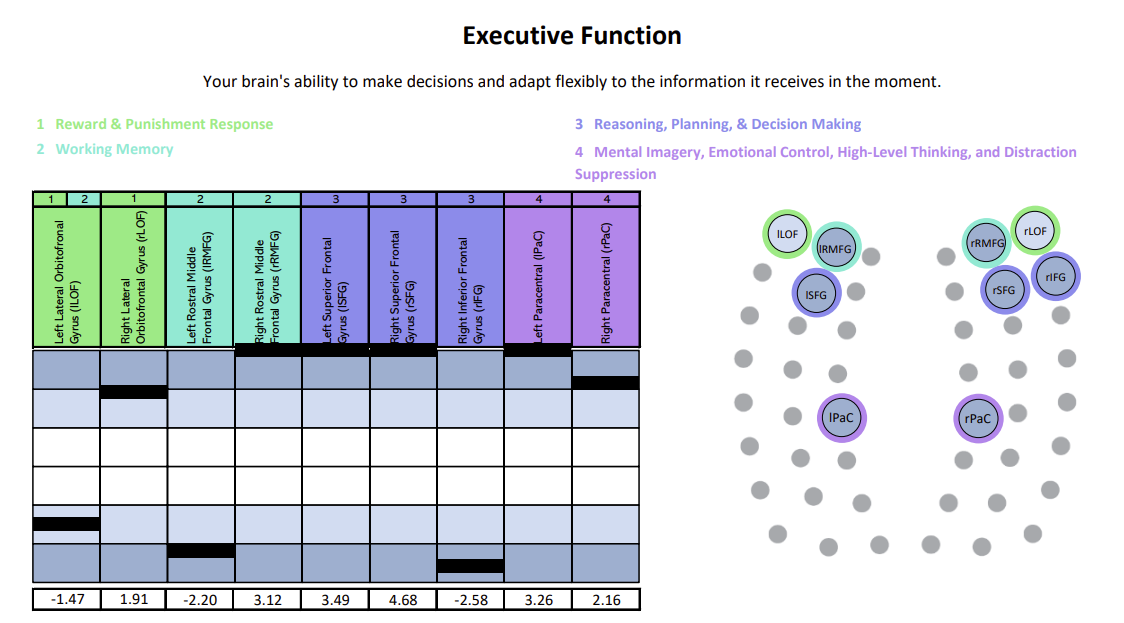
Each chart shows how a specific brain region is functioning compared to normal. The white area represents the normal range, with the center line marking the average. Light and dark blue zones show increasing levels of abnormality.
A black line marks the patient’s result for that region—ideally landing within the white. Lines in the light and dark blue zones suggest that the region is either hyperactive (blue zones above the white) or hypoactive (blue zones beneath the white).
In the graph above, for example, a patient had hyperactivity in certain brain regions and hypoactivity in others.
This detailed view of brain function allows us to tailor each person’s therapy precisely to their needs—one of the core things that sets Cognitive FX apart.
After patients complete this evaluation, our team combines all the information and designs a customized treatment plan to target exactly the areas of the brain that show dysfunction for each patient.
Treatment for persistent post-concussion syndrome involves a three-step cycle that repeats: Prepare, Activate, and Recover.

Therapy starts with short bursts of aerobic exercise, usually on the treadmill or stationary bike. As described earlier, exercise triggers the release of important chemicals in the brain, which help the patient's brain become more flexible and boost the effects of subsequent therapy.
Our therapists are trained to help patients exercise according to their needs without triggering severe symptoms. Even patients who struggle with physical activity due to balance problems can make remarkable progress in these sessions.
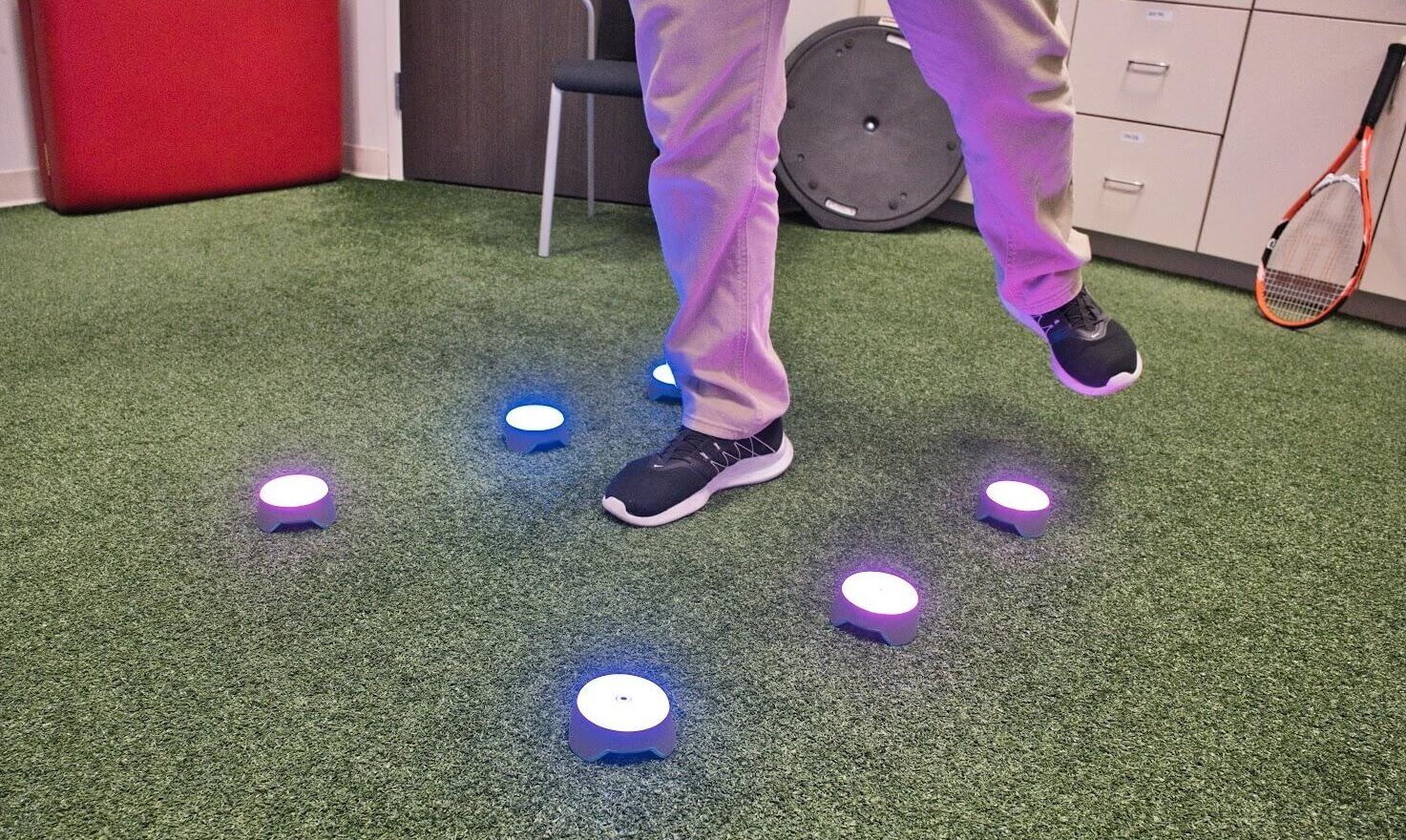
After exercise, patients attend a variety of therapies, including cognitive therapy, sensorimotor therapy, neuromuscular therapy, Dynavision therapy, occupational therapy, neurointegration therapy, vision and vestibular therapy, and psychotherapy, to name just a few. Patients receive all or most of these therapies during their visit, but the exact regimen for each one is unique to them.
Our therapists often combine exercises from different disciplines for greater effect.
For example, you might balance on a Bosu ball to engage your vestibular system and brain’s balance center while tossing color-coded tennis balls to work hand-eye coordination and reflexes. Meanwhile, you’ll add or subtract from a running tally based on which ball you catch, challenging memory, problem-solving, and attention.
During neurointegration therapy, you might draw a mirror image of a pattern while answering simple questions from your therapist.
Rest periods are an important part of our treatment. Some examples of scheduled brain breaks include:
Neuromuscular massage: Therapists massage the neck and shoulders to relieve chronic pain and tension, relax muscles involved in vision, improve circulation, and alleviate headache pain.
Brainwaves: The binaural beats app we use produces two frequencies that are very close together. If you listen to a different frequency in each ear, your brain will average them together to produce one frequency. We set the parameters so that the frequency your brain creates is the same frequency you would experience through meditation. This frequency will propagate in your brain waves as you listen. As a result, you gain some of the restorative benefits of meditation without being a meditation expert.
Mindfulness: Patients learn mindfulness techniques during their time at the clinic.
At the end of treatment, patients undergo a second brain imaging scan to check on their progress. They then meet with one of our therapists to review the results and receive a series of at-home exercises. These typically include physical activities, cognitive tasks, visual and vestibular exercises, and relaxation techniques. We recommend patients perform these exercises for about an hour, five times a week initially, with the frequency decreasing as symptoms improve.
For patients needing further therapy, we provide referrals to appropriate specialists.
Over 90% of our PCS patients experience significant recovery after treatment in our clinic. To determine if our program is right for you, please schedule a consultation with our team.

Dr. Alina K. Fong received her Ph. D. in Clinical Neuropsychology with an emphasis in neuroradiology from Brigham Young University. She received the national American Psychological Association Clinical Neuropsychology Division 40 Graduate Student Research Award in 2004 for her research on "Cortical Sources of the N400 and 'The N400 Effect." Dr. Fong's interest in brain mapping soon turned to functional MRI, and since then, her research efforts have been focused on the clinical applications of fMRI.
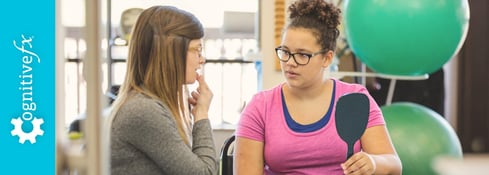
Many people associate stuttering with childhood, but a sudden onset of stuttering can also occur after a head injury. This phenomenon, known as acquired stuttering, is one of many symptoms that can...
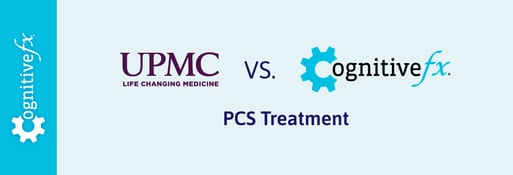
The University of Pittsburgh Medical Center (UPMC) is a world-renowned healthcare provider and insurer with groundbreaking work in research, treatments, and clinical care. UPMC runs 40 hospitals and...
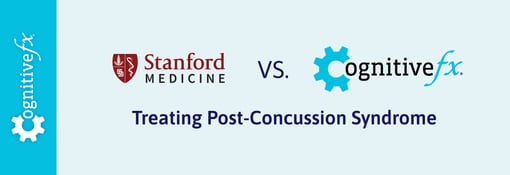
If you're suffering from persistent symptoms after a concussion — a condition calledpost-concussion syndrome (PCS)— you might think that Stanford Healthcare (part of Stanford University) would be a...

Post-concussion syndrome is downright frustrating to experience. Doctors often miss it during diagnosis, and even if they do make the diagnosis, treatment methods vary considerably from clinic to...

If you’ve had a severe or mild traumatic brain injury (severe TBI or mild TBI) that’s left you with post-concussion syndrome (PCS), just thinking can be taxing. Cognitive health is “the ability to...

From a small outpatient clinic in the 1920s, Cleveland Clinic has grown to become one of the world’s largest integrated medical systems. With over 65,000 providers worldwide, Cleveland Clinic has...
Published peer-reviewed research shows that Cognitive FX treatment leads to meaningful symptom reduction in post-concussion symptoms for 77% of study participants. Cognitive FX is the only PCS clinic with third-party validated treatment outcomes.
READ FULL STUDY